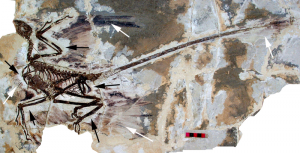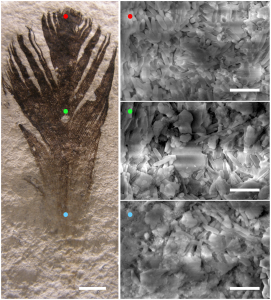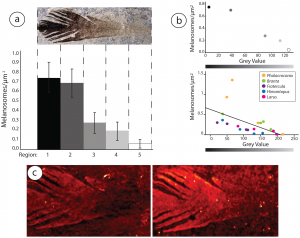The origin and evolution of dinosaur feathers, and their colour and function, has been high up on the pecking order for palaeontologists of late. The adaptive poetry that unfolds from fossil finds allows us to bear witness to one of the most beautiful transformations in the history of life on Earth, and the attention to this story is rightly deserved. I’ve devoted quite a bit of this blog to writing about the whole dinosaur to bird transition before, in terms of flight mechanics, flight styles, evolution of flappable wings, feather distributions, sexing dino-birds, and whether new finds are actually worth raving about.

Microraptor gui is an infamous example of a feathered dinosaur (source)
But the story keeps on being added to – there are many blank pages to fill. Just because we now have a pretty good picture of how the transition happened, what the phases in evolutionary renovation were, and are able to reconstruct the lives of magnificent feathered dinosaurs, doesn’t mean palaeontologists are gonna stop palaeontology-ising. We’re chipping away at the base of the mountain.
Most of the cool new fossils and studies have come from China, and from global collaborations. Exquisite remains of entombed animals are being unearthed from their graveyards in some dinosaur zombie apocalypse parody, and museums are casually over-flowing. Fossils illustrating the dinosaur-bird transitional phases are considerably rarer from outside of China though. Archaeopteryx is an exception, from Bavaria in Germany, but one of the last places you’d probably expect to find fossil birds is Scandanavia.
A new feather has been described in microscopic detail from 55 million year old rocks from Denmark, belonging to an animal that lived beyond the reign of non-avian dinosaurs, and would have been an ancestral precursor to one of the avian dinosaurs that tweet from the treetops today.
Scanning electron microscopy involves taking a specimen, and bombarding it with electrons to build up an image of objects, and has been used to peer into fossils in insanely high detail, more than we’d ever dreamed possible some years ago. Past uses include detecting colour-bearing organelles in feathers that reveal the colours of ancient dinosaurs. This new analysis goes a step further, by looking at the concentration of these objects to determine the gradient of colour variation.
By observing the concentration of these melanin-bearing structures, called melanosomes, we can see if any patterns can be discovered and try and figure out what they might mean. Considering birds are one of the most ecologically successful groups of modern vertebrates (fish are far too boring to count), unravelling the evolutionary trajectories of their ecological success is a pretty awesome thing to study. Importantly, figuring out why feathers initially evolved is a big part of this story, as to begin with it is unlikely that feather precursors, similar to what you see on baby chickens, could give an animal the ability to fly (the ‘Icarus effect’ in early feathered dinosaurs).

The complete feather, and it’s constituent melanosomes freed from their keratin cages. (source)
Humans also possess melanin in their hair. Their concentration relates to darkness, so it’s likely that if you have paler shades of hair then you have a lower density of melanin, but is the same for dinosaurs and their melanosome-bearing feathers?
Synchrotrons are mini particle colliders. It makes perfect sense that invaluable fossils should be popped in them, in the name of science, and that’s exactly what this team did. They fired a beam of electrons at the fossil to produce an element map of the feather, as this technique has been shown previously to reveal much about the true colour of fossil feathers. The equipment is also totally cool, possessing bits of gear like a ‘silicon drift Vortex detector’, which monitors the scatter of electrons after they whap the fossil.
Using a tonne of modern bird feathers as a training set for the analysis, they found that the grey-scale of feathers is strongly related to the concentration of melanosomes, and also not related in any way to the ubiquitous processes of burial and decay that inflict fossils in various ways. The synchrotron analysis also showed that this gradient relates to the concentrations of both copper and zinc, adding another neat bit of geochemical evidence.
What this showed is that in the fossil feather, from the tip to the base, there was a gradual decrease in grey-scale from black to white, with a major transition in the middle which seems to be related to a lateral thinning of the feather. This is quite cool, as it’s how the feather looks superficially, but initially you might just think is an artefact of the gradual dimming of the fossil through time.

The colour gradient, and false colour images showing the concentrations of copper (left) and zinc (right) (source)
Even more cool about this is when you relate it back to modern birds. Colour gradients within individual feathers of this sort are seen in waterbirds like penguins, and therefore provide a strong ecological signal. This adds an additional subtle dimension to the study of fossil colours in birds, which previously have focussed on discrete regions of colour, as opposed to a more gradual state which can reveal much about the ecology of extinct animals.
I don’t know about you, but I think it’s pretty awesome to think that just 10 million years after your non-avian dinos went kaput, birds had already diversified way beyond their initial experimental phases and occupied the land and the sea, and were generally kicking ecological ass. Of course, this is only one feather, so making sweeping assumptions about all birds around this time is a bit much, but it certainly does hint that there are greater sagas hidden within fossils yet to be exposed.
But wait, there’s more still! Such gradients reveal to us clues about the biochemistry of birds, and their physiological development. Making melanin is a costly process. Ask your local fair-skinned buddies, and they’ll probably tell you that they’re lacking in the hormone that triggers melanin development; in this case L-tyrosine, which produces melanin in birds by an energy-costly pathway. As the addition of melanin to feathers may do more than provide colour, such as provide mechanical integrity or prevent bacterial degradation, the gradients could suggest something about the lifestyle of ancient birds with respect to these.
Perhaps the ends of the feathers were more densely packed with these melanosomes to provide additional structural support as they zipped through the water, hunting unlucky fish and darting around with nimble direction shifts and gear changes. Perhaps initially in feathered dinosaurs, melanin was developed for sexual display as frequently hypothesised, but then later took on new roles as birds diversified and adapted into new ecological roles. During this, they conserved their developmental energy by concentrating melanin only where needed most, which secondarily translated into colour variation.
Maybe. That’s the beauty of fossils – they train your imagination, and allow you to recreate stories that we’ll never see, and only you can tell. What do you think these gradients tell us about the life of these ancient dino-birds?
Reference:
Daniel J. Field, Liliana D’Alba, Jakob Vinther, Samuel M. Webb, William Gearty, Matthew D. Shawkey (2013). Melanin Concentration Gradients in Modern and Fossil Feathers PLoS ONE DOI: 10.1371/journal.pone.0059451

Pingback: Morsels for the mind – 19/7/2013 › Six Incredible Things Before Breakfast